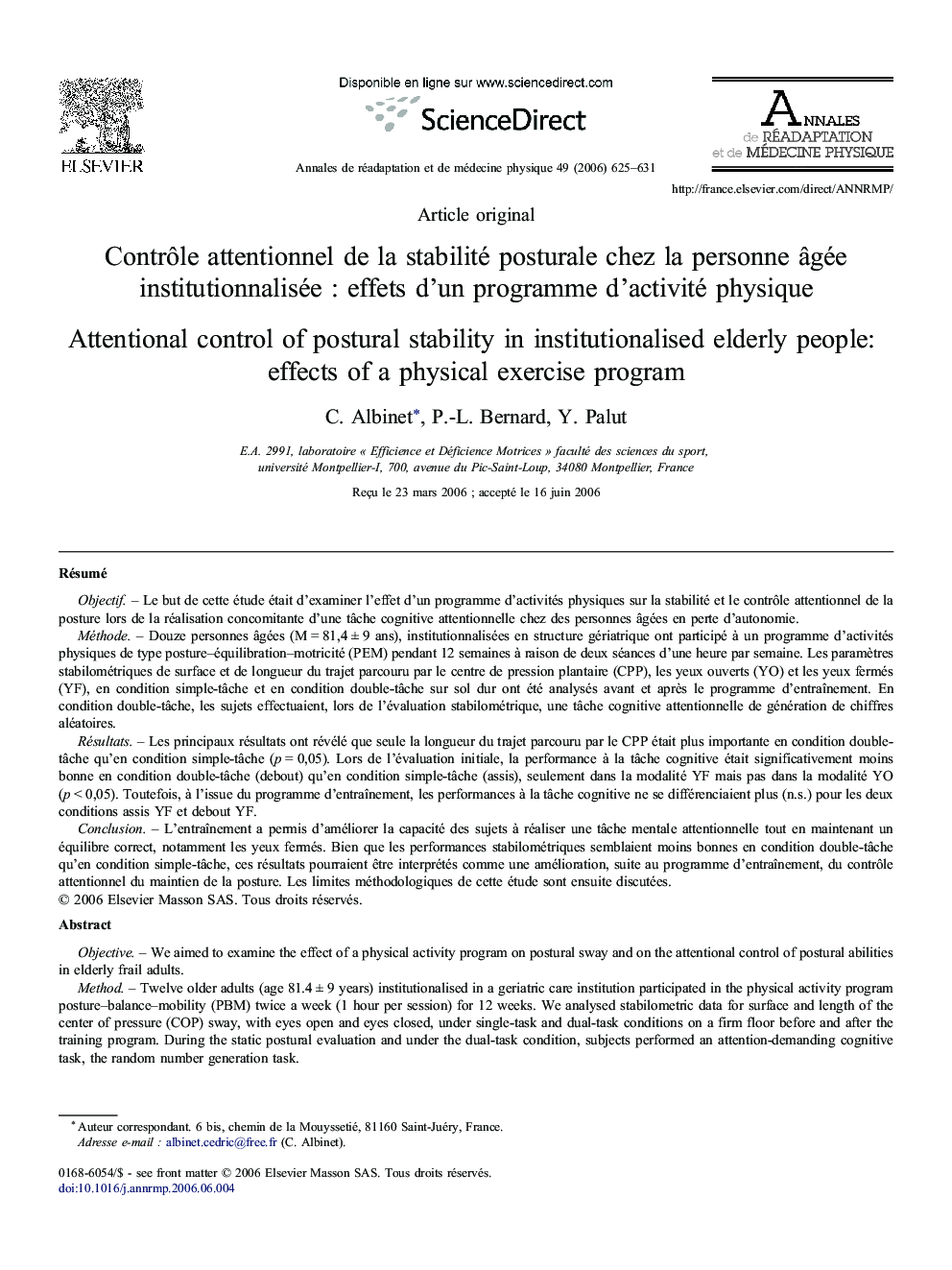| Article ID | Journal | Published Year | Pages | File Type |
|---|---|---|---|---|
| 4040313 | Annales de Réadaptation et de Médecine Physique | 2006 | 7 Pages |
RésuméObjectifLe but de cette étude était d'examiner l'effet d'un programme d'activités physiques sur la stabilité et le contrôle attentionnel de la posture lors de la réalisation concomitante d'une tâche cognitive attentionnelle chez des personnes âgées en perte d'autonomie.MéthodeDouze personnes âgées (M = 81,4 ± 9 ans), institutionnalisées en structure gériatrique ont participé à un programme d'activités physiques de type posture–équilibration–motricité (PEM) pendant 12 semaines à raison de deux séances d'une heure par semaine. Les paramètres stabilométriques de surface et de longueur du trajet parcouru par le centre de pression plantaire (CPP), les yeux ouverts (YO) et les yeux fermés (YF), en condition simple-tâche et en condition double-tâche sur sol dur ont été analysés avant et après le programme d'entraînement. En condition double-tâche, les sujets effectuaient, lors de l'évaluation stabilométrique, une tâche cognitive attentionnelle de génération de chiffres aléatoires.RésultatsLes principaux résultats ont révélé que seule la longueur du trajet parcouru par le CPP était plus importante en condition double-tâche qu'en condition simple-tâche (p = 0,05). Lors de l'évaluation initiale, la performance à la tâche cognitive était significativement moins bonne en condition double-tâche (debout) qu'en condition simple-tâche (assis), seulement dans la modalité YF mais pas dans la modalité YO (p < 0,05). Toutefois, à l'issue du programme d'entraînement, les performances à la tâche cognitive ne se différenciaient plus (n.s.) pour les deux conditions assis YF et debout YF.ConclusionL'entraînement a permis d'améliorer la capacité des sujets à réaliser une tâche mentale attentionnelle tout en maintenant un équilibre correct, notamment les yeux fermés. Bien que les performances stabilométriques semblaient moins bonnes en condition double-tâche qu'en condition simple-tâche, ces résultats pourraient être interprétés comme une amélioration, suite au programme d'entraînement, du contrôle attentionnel du maintien de la posture. Les limites méthodologiques de cette étude sont ensuite discutées.
ObjectiveWe aimed to examine the effect of a physical activity program on postural sway and on the attentional control of postural abilities in elderly frail adults.MethodTwelve older adults (age 81.4 ± 9 years) institutionalised in a geriatric care institution participated in the physical activity program posture–balance–mobility (PBM) twice a week (1 hour per session) for 12 weeks. We analysed stabilometric data for surface and length of the center of pressure (COP) sway, with eyes open and eyes closed, under single-task and dual-task conditions on a firm floor before and after the training program. During the static postural evaluation and under the dual-task condition, subjects performed an attention-demanding cognitive task, the random number generation task.ResultsOnly the length of COP sway was more important under the dual-task condition than under the single-task condition (p = 0.05). At baseline, cognitive performance was significantly weaker under the dual-task condition (standing) than under the single-task condition (seated), with eyes closed but not eyes open (p < 0.05). However, after the training program, the performance of the cognitive task did not significantly differ between the dual-task condition with eyes closed and the single-task condition with eyes closed.ConclusionThe training program allowed elderly subjects to improve their ability to perform an attention-demanding cognitive task while standing still, in particular with their eyes closed. Although balance seemed to be less stable under the dual-task condition than under the single-task condition, these results could be interpreted as an improvement of the attentional control of postural stability.
